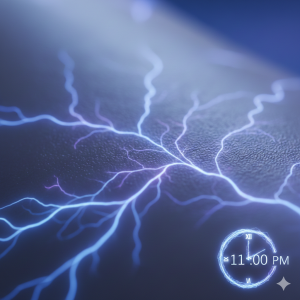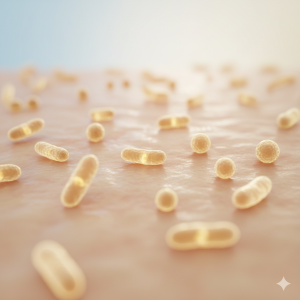Hello, and welcome. As a doctor, I’ve had countless conversations with patients about their health, and one topic that always seems to come up is the quest for a more youthful appearance and a feeling of well-being. We often talk about the right creams, treatments, and diets, but there’s one incredibly powerful tool that’s often overlooked: sleep.
I know what you’re thinking. “I know, I know, I need to get more sleep.” We’ve all heard that advice a thousand times. But what if I told you it’s not just about the number of hours you spend in bed? It’s about the quality of that sleep—specifically, the science behind your sleep cycles and their profound impact on cellular repair and, yes, the health and vibrancy of your skin.
The Four Stages of Sleep: A Nightly Symphony of Repair
Sleep isn’t a single, uniform state of rest.1 It’s a complex, dynamic process that cycles through four distinct stages: three stages of non-rapid eye movement (NREM) sleep and one stage of rapid eye movement (REM) sleep.2 Throughout a typical night, your body performs a delicate dance between these stages, each with its own critical role in cellular restoration.
Let’s break down this nightly symphony.
- NREM Stage 1: The ‘Dozing Off’ Phase. This is the lightest stage of sleep, where you’re just drifting off. Your muscles relax, your heart rate slows, and your brain waves begin to change. While important for transitioning into deeper sleep, this stage isn’t where the real heavy lifting happens for cellular repair. Think of it as the overture to the main event.
- NREM Stage 2: The ‘Settling In’ Phase. Your heart rate and breathing slow down further, and your body temperature drops. Your brain starts to show unique patterns called sleep spindles and K-complexes, which are believed to play a role in consolidating memories.3 It’s a deeper state of rest, preparing the body for what’s to come.
- NREM Stage 3: The ‘Deep Sleep’ Powerhouse. This is the star of the show for cellular repair. Often called “slow-wave sleep” due to the slow brain waves seen on an EEG, this is when your body releases a significant amount of human growth hormone (HGH). HGH is not just for growing taller; it’s a powerful anti-aging hormone. It’s responsible for stimulating cell reproduction and regeneration. For your skin, this translates directly to a boost in collagen production. Collagen, as you likely know, is the protein that gives your skin its firmness, elasticity, and youthful glow.4
I remember a patient, let’s call her Sarah, who came to see me with concerns about dull, tired-looking skin and fine lines. She was a busy professional, getting about 6 hours of sleep a night, but she insisted she felt fine. We talked about her sleep habits, and I explained the crucial role of deep sleep. She started making a conscious effort to improve her sleep hygiene—going to bed at the same time, turning off screens an hour before bed, and creating a calming ritual. A few weeks later, she came back for a follow-up. The change was remarkable. Her skin had a visible radiance, and she herself noted how much more refreshed she felt. It was a tangible example of the power of prioritizing deep sleep.
- REM Sleep: The ‘Mental and Cellular Cleanup’ Phase. The final stage of the cycle is REM sleep, where your brain is highly active, you dream, and your eyes move rapidly.5 While it’s often associated with cognitive functions like memory consolidation, REM sleep also plays a key role in cellular turnover. Think of this stage as the body’s nightly housekeeping. It’s when your cells repair themselves, and the process of shedding old, damaged cells to make way for new ones accelerates. This is particularly important for skin health, helping to maintain that fresh, clear complexion by ensuring a consistent turnover of skin cells.
Actionable Tips for Maximizing Your Sleep’s Repair Power
So, how can you ensure you’re getting the most out of these vital sleep cycles? Here are some actionable tips:
- Prioritize Consistency: Your body loves routine. Going to bed and waking up at the same time every day, even on weekends, helps regulate your internal body clock, or circadian rhythm.6 A consistent rhythm makes it easier for your body to move through the deep, restorative stages of sleep.
- Create a Sanctuary: Your bedroom should be a haven for sleep. Make it dark, quiet, and cool. Even a small amount of light can disrupt melatonin production, the hormone that signals to your body that it’s time to sleep.7
- Mind Your Screen Time: The blue light emitted from phones, tablets, and TVs can suppress melatonin production and trick your brain into thinking it’s still daytime.8 Aim to turn off all screens at least an hour before you plan to go to sleep.
- Incorporate Relaxing Rituals: A warm bath, reading a physical book, or gentle stretching can signal to your body that it’s time to wind down.9 This helps your brain and body prepare for the deep, restorative sleep they need.
Connecting Sleep to Your Skin Rejuvenation Journey
The connection between your sleep and your skin health is undeniable. While topical treatments, facials, and advanced services like injectables and laser therapies are incredibly effective in addressing specific concerns, they are most powerful when combined with a strong foundation of internal health. Think of it this way: our clinic’s services are the expert gardeners, but your sleep is the nutrient-rich soil that allows the plants to truly flourish.
By understanding and prioritizing the science of your sleep cycles, you’re not just resting; you’re actively engaging in a powerful, natural form of anti-aging and cellular repair. It’s a simple, yet profound, act of self-care that has a ripple effect on your entire body, leaving you looking and feeling more refreshed, revitalized, and radiant.
If you’d like to learn more about how our skin rejuvenation services can complement your new sleep habits and help you achieve your aesthetic goals, please don’t hesitate to book a consultation. We’re here to help you on your journey to feeling and looking your absolute best.




